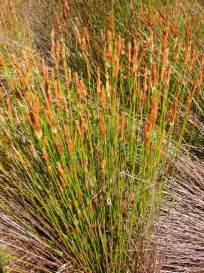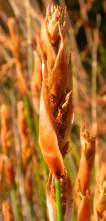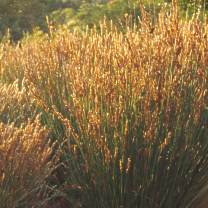Elegia equisetacea
Elegia equisetacea (Mast.) Mast.
Family: Restionaceae
Common names:
Introduction
This is an attractive reed-like plant with large, golden seed heads forming a bright patch in a garden where it will dance and whisper in the wind.

Description
Description
Elegia equisetacea is a medium to tall, tufted, reed-like plant with straight stems, which grow to a height of about 1.5 m. In the southern hemisphere the stems are topped with long inflorescences with large golden bracts from about March to September.

During the first few months of the year the bracts hide the small spikelets of male or female flowers, then in June and July the bracts open slightly to facilitate the pollination of the flowers. The bracts of the female plants stay on the plant while the seed is ripening and only start to become less attractive when the seed is ready to fall in November. The bracts of the male plants fall off when the pollen is ripe. By this time the length of the male inflorescence can be well over 400 mm.

The plants reach a height of about 1 m during the second year after sowing and will have reached their full height after flowering in the third year. In their natural environment the plants are quite long-lived; in the garden, with richer soil and a more generous supply of water they will live at least 7 years.

While the stems are growing it is interesting to observe the space between the nodes in the stem. When the stem has only just emerged out of the ground, the nodes are close together and are protected by a 'sheath' or a curled up, leaf-like structure around the stem. The growth point of the stem is not at the top of the stem, but just above each node. The function of the sheath is to strengthen the stem just where it is at its weakest during the growth process. Once the stem is full-grown the sheath is not needed anymore, stands away from the stem and eventually falls off, leaving an abscission line. At this later stage the sheaths, and to a lesser degree the bracts around the inflorescences, become quite papery and make a rustling noise in the wind.
Distribution and habitat
Distribution description
E. equisetacea is a very widespread species and occurs from the Cederberg in Western Cape to Port Elizabeth in Eastern Cape. Its habitat varies from the mountains to the plains around Bredasdorp, from acidic soils derived from sandstone to limestone soils. It is mostly found in slight seepages and along streams, but in the southern Cape it is often found on well-drained slopes. It is a common species and can grow in large, dense stands. Depending on where the plants are growing in their distribution range, the stems can be single and straight or branching or they can have branches whorled at each node during their first years, when they may look similar to E. capensis. The older plants can be confused with E. juncea.
Derivation of name and historical aspects
History
The name Elegia is presumed to come from the Greek elegeia, a song of lamentation, and may be a reference to the rustling sound of the papery sheaths and bracts in the breeze. The species name equisetacea is derived from the Latin, equisetum, meaning horsetails. This refers to the similarity in the vegetative growth form of the young plants of this species and the genus Equisetum. The genus Elegia is large and widespread geographically in the western and southern Cape and occurs from near sea level to the top of the mountains. One of the most popular and widely grown members of this genus is E. capensis, with its whorls of long, leafy looking stems at each node of the tall stems. There are 37 species in this genus but this number may change in the future, as many species still have not been determined conclusively by the taxonomist working on them.
Ecology
Ecology
This species is wind pollinated, with the male plants in the population flowering during a longer period than the female plants, so as to ensure as large a seed set as possible. The female plants also flower over an extended period, resulting in mature seeds occurring on some spikes while others are still flowering. The seed is a small nutlet surrounded by small wings. The wings make the dispersal of the seed by the wind more effective. A strange feature of the genus Elegia is that a large percentage of the seed is 'empty', even though the seed coat and the wings are formed and the undeveloped seed looks exactly the same as the viable seed. Why the plant would use up so much energy to form seed that is not viable, is not known.
Uses
Use
Elegia equisetacea has been introduced commercially into the horticultural market and is available in South Africa for growing in gardens. Because of the sturdy nature of the mature stems, this species was probably used for thatching in the past.
Growing Elegia equisetacea
Grow

This species is best used as part of a mixed border or in a group in a Mediterranean or fynbos garden. Because the rhizomes do not spread, the plant can be grown in a large pot. The plants blend well with fynbos, other indigenous South African plants as well as any other plants in a garden. They can be used as small shrubs or to provide a grass-like touch, now so fashionable in landscaping. The plants are best grown from seed, which has a good germination rate and germinates even better if treated with smoke or 'Instant Smoke Plus' seed primer. Sow seed after it has been cleaned of impurities. It is virtually impossible to separate the undeveloped seed from the viable seed as this is normally done by placing the seed in water where the viable seed sinks down and the infertile seed floats, but with seed of the genera which have winged seeds, namely Elegia, Thamnochortus and Staberoha, this is not possible, as the wings keep all seeds afloat.
Seed is best sown in autumn when day and night temperatures are about 15°C apart. Nights have cooled to about 10°C with day temperatures about 25° C. Sow in a well-drained medium in seed trays and cover with a thin layer of medium milled bark. Water moderately. Germination takes about 3 weeks. Prick out the seedlings into individual containers once the first true stems/culms have developed. They should be ready for planting out in the garden by the following autumn.
This species must be grown in full sun, prefers a well-drained soil and plenty of air movement. The plants adapt to a large variety of soil types. The best time for planting restios is at the beginning of the rainy season, as the plants need regular watering, especially during the first six weeks to two months after planting. The plants may be fed with standard organic fertilizers, slow release fertilizers, or by sprinkling the surrounding soil with a small amount of ammonium sulfate during the growing season. This is a fast-growing species that will be nearly 1 m high one year after sowing and will have formed a handsome plant after three years. The plants produce a new growth flush every year. The individual stems start to deteriorate during the third year, but by that time, two new flushes of growth will have appeared for the yearly renewal of the plant. This governs the maintenance of the plant, which only needs a regular removal of the brown, dead stems.
References
- Andrews, S. & McClintock, D. 1982. Notes on Restio subverticellatus. The Plantsman 37: 230-233.
- Brown, N., Jamieson, H. & Botha, P. 1998. Grow restios. Kirstenbosch Gardening Series, National Botanical Institute, Cape Town.
- Dorrat-Haaksma, E.& Linder, H.P. 2000. Restios of the Fynbos. The Botanical Society of South Africa, Cape Town.
- Kesting, D. 2001. Wild flowers of the Cape Peninsula. Botanical names: origins and meanings. Friends of the Silvermine Nature Area, St James, Cape Town.
- Linder, H.P. 1985. Conspectus of the African species of Restionaceae. Bothalia 15: 387-503.
- Linder, H.P. 1991. A review of the southern African Restionaceae. Contributions from the Bolus Herbarium 13: 209-264.
Credits
Hanneke Jamieson
Kirstenbosch National Botanical Garden
July 2003
Plant Attributes:
Plant Type: Restio
SA Distribution: Eastern Cape, Western Cape
Soil type: Sandy, Clay, Loam
Flowering season: Spring, Winter
PH: Acid, Alkaline, Neutral
Flower colour: Brown
Aspect: Full Sun
Gardening skill: Average
Special Features:
Horticultural zones








Rate this article
Article well written and informative
Rate this plant
Is this an interesting plant?
Login to add your Comment
Back to topNot registered yet? Click here to register.